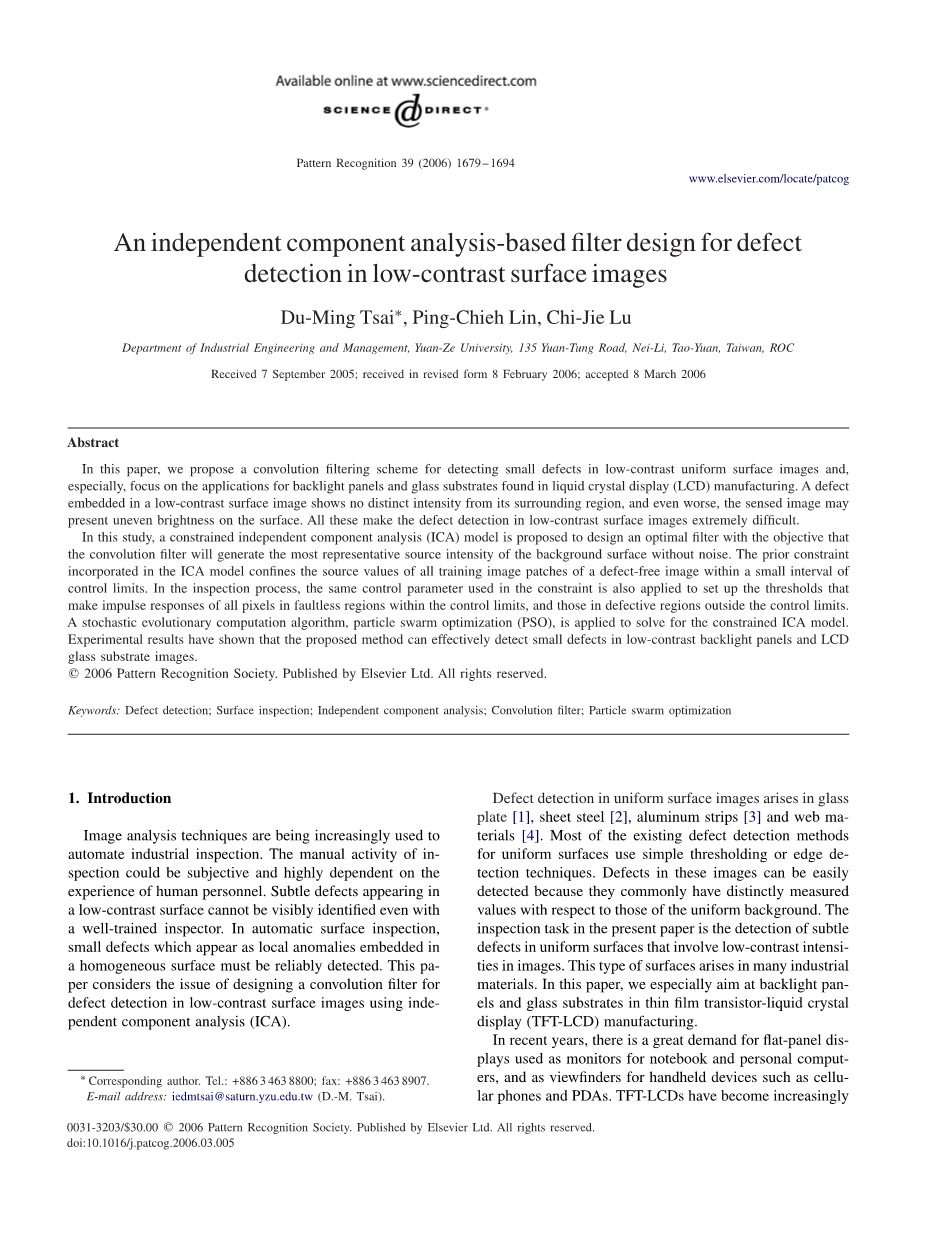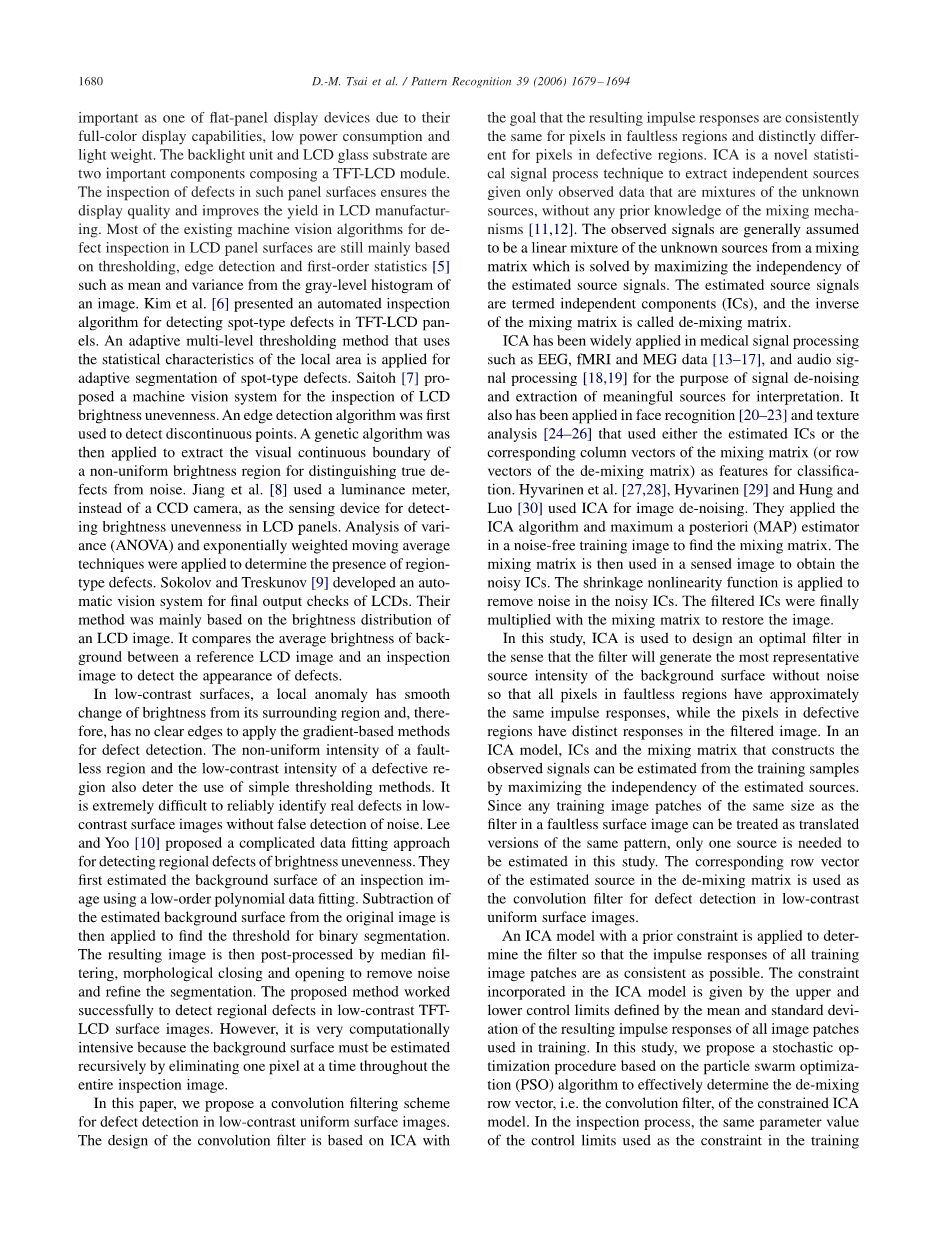未加工接合面视觉检测算法研究与实现外文翻译资料
2021-12-30 22:41:38


英语原文共 16 页,剩余内容已隐藏,支付完成后下载完整资料
Pattern Recognition 39 (2006) 1679 – 1694
www.elsevier.com/locate/patcog
An independent component analysis-based filter design for defect detection in low-contrast surface images
Du-Ming Tsai , Ping-Chieh Lin, Chi-Jie Lu
Department of Industrial Engineering and Management, Yuan-Ze University, 135 Yuan-Tung Road, Nei-Li, Tao-Yuan, Taiwan, ROC
Received 7 September 2005; received in revised form 8 February 2006; accepted 8 March 2006
Abstract
In this paper, we propose a convolution filtering scheme for detecting small defects in low-contrast uniform surface images and, especially, focus on the applications for backlight panels and glass substrates found in liquid crystal display (LCD) manufacturing. A defect embedded in a low-contrast surface image shows no distinct intensity from its surrounding region, and even worse, the sensed image may present uneven brightness on the surface. All these make the defect detection in low-contrast surface images extremely difficult.
In this study, a constrained independent component analysis (ICA) model is proposed to design an optimal filter with the objective that the convolution filter will generate the most representative source intensity of the background surface without noise. The prior constraint incorporated in the ICA model confines the source values of all training image patches of a defect-free image within a small interval of control limits. In the inspection process, the same control parameter used in the constraint is also applied to set up the thresholds that make impulse responses of all pixels in faultless regions within the control limits, and those in defective regions outside the control limits. A stochastic evolutionary computation algorithm, particle swarm optimization (PSO), is applied to solve for the constrained ICA model. Experimental results have shown that the proposed method can effectively detect small defects in low-contrast backlight panels and LCD glass substrate images.
2006 Pattern Recognition Society. Published by Elsevier Ltd. All rights reserved.
Keywords: Defect detection; Surface inspection; Independent component analysis; Convolution filter; Particle swarm optimization
1. Introduction
Image analysis techniques are being increasingly used to automate industrial inspection. The manual activity of in-spection could be subjective and highly dependent on the experience of human personnel. Subtle defects appearing in a low-contrast surface cannot be visibly identified even with a well-trained inspector. In automatic surface inspection, small defects which appear as local anomalies embedded in a homogeneous surface must be reliably detected. This pa-per considers the issue of designing a convolution filter for defect detection in low-contrast surface images using inde-pendent component analysis (ICA).
Corresponding author. Tel.: 886 3 463 8800; fax: 886 3 463 8907. E-mail address: iedmtsai@saturn.yzu.edu.tw (D.-M. Tsai).
Defect detection in uniform surface images arises in glass plate [1], sheet steel [2], aluminum strips [3] and web ma-terials [4]. Most of the existing defect detection methods for uniform surfaces use simple thresholding or edge de-tection techniques. Defects in these images can be easily detected because they commonly have distinctly measured values with respect to those of the uniform background. The inspection task in the present paper is the detection of subtle defects in uniform surfaces that involve low-contrast intensi-ties in images. This type of surfaces arises in many industrial materials. In this paper, we especially aim at backlight pan-els and glass substrates in thin film transistor-liquid crystal display (TFT-LCD) manufacturing.
In recent years, there is a great demand for flat-panel dis-plays used as monitors for notebook and personal comput-ers, and as viewfinders for handheld devices such as cellu-lar phones and PDAs. TFT-LCDs have become increasingly
0031-3203/$30.00 2006 Pattern Recognition Society. Published by Elsevier Ltd. All rights reserved.
doi:10.1016/j.patcog.2006.03.005
1680 D.-M. Tsai et al. / Pattern Recognition 39 (2006) 1679 – 1694
important as one of flat-panel display devices due to their full-color display capabilities, low power consumption and light weight. The backlight unit and LCD glass substrate are two important components composing a TFT-LCD module. The inspection of defects in such panel surfaces ensures the display quality and improves the yield in LCD manufactur-ing. Most of the existing machine vision algorithms for de-fect inspection in LCD panel surfaces are still mainly based on thresholding, edge detection and first-order statistics [5] such as mean and variance from the gray-level histogram of an image. Kim et al. [6] presented an automated inspection algorithm for detecting spot-type defects in TFT-LCD pan-els. An adaptive multi-level thresholding method that uses the statistical characteristics of the local area is applied for adaptive segmentation of spot-type defects. Saitoh [7] pro-posed a machine vision system for the inspection of LCD brightness unevenness. An edge detection algorithm was first used to detect discontinuous points. A genetic algorithm was then applied to extract the visual continuous boundary of a non-uniform brightness region for distinguishing true de-fects from noise. Jiang et al. [8] used a luminance meter, instead of a CCD camera, as the sensing device for detect-ing brightness unevenness in LCD panel
全文共81006字,剩余内容已隐藏,支付完成后下载完整资料
资料编号:[2770]




